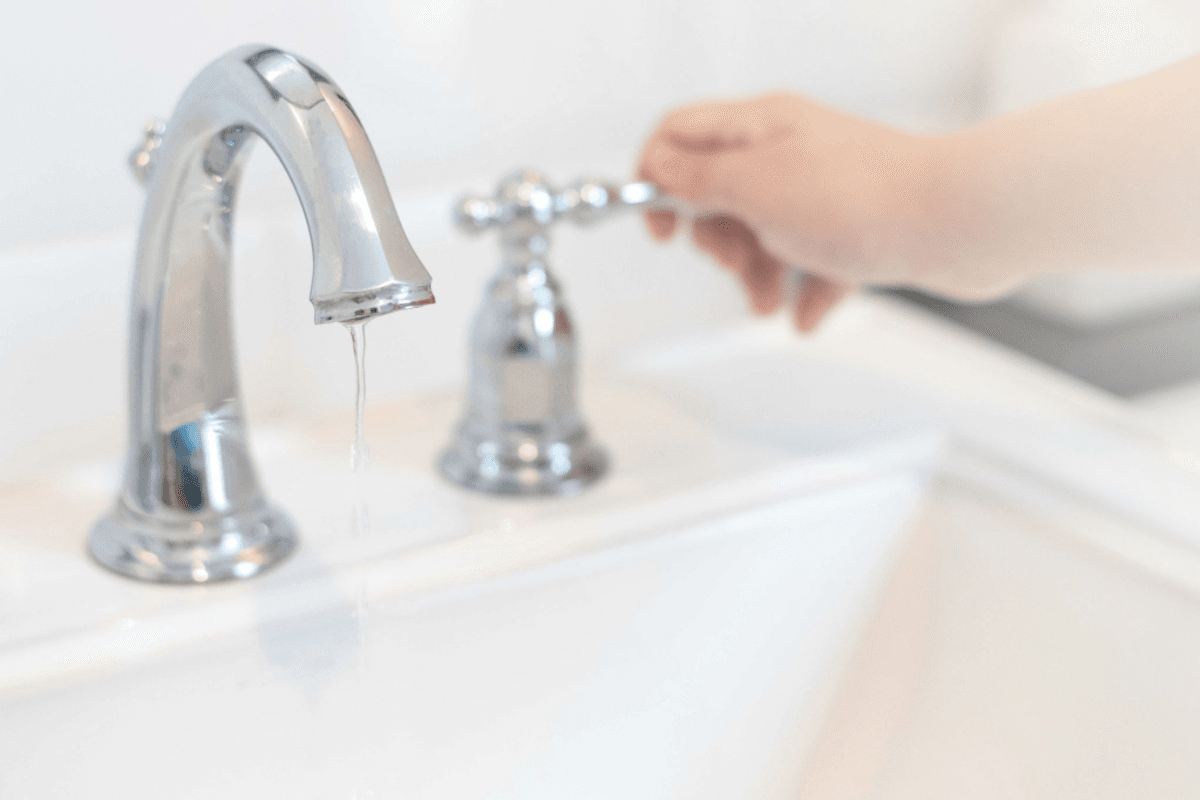Welcome to Service by Scott, your trusted partner in plumbing and maintenance for over three decades. As a family-owned and operated business serving Woodville, Texas, and neighboring areas, we understand the unique challenges that winter brings to your plumbing system. One of the most common and potentially costly issues during the colder months is frozen pipes. That’s why we’re here to guide you through the essential steps to prevent this inconvenient and potentially damaging problem.
The frigid temperatures of winter can wreak havoc on your plumbing if not properly prepared. From burst pipes to disrupted water flow, the consequences of frozen pipes can be both costly and inconvenient. But don’t worry; with the right knowledge and proactive measures, you can safeguard your home against the chilling grip of winter. In this comprehensive guide, we’ll walk you through the best practices to keep your pipes safe, your water flowing, and your home cozy throughout the winter season.
At Service by Scott, we believe that prevention is key when it comes to protecting your plumbing. Beyond providing top-notch plumbing services, our mission is to empower homeowners with the knowledge and tools they need to maintain a well-functioning plumbing system year-round. So, let’s dive in and explore the steps you can take to ensure that Jack Frost doesn’t get the best of your pipes this winter.
Insulate Your Pipes
When it comes to safeguarding your plumbing from the harsh bite of winter, insulating your pipes is a fundamental step that can make a world of difference. Proper insulation acts as a protective barrier, helping to keep your pipes warm and preventing them from freezing. In this section, we’ll delve into the ins and outs of pipe insulation, including materials, where to insulate, how to do it correctly, and the numerous benefits it brings.
Insulation Materials
Selecting the right insulation materials is crucial for effective pipe protection. There are various options available, each with its own set of advantages and applications. One common choice is foam pipe insulation, which comes in pre-slit tubes that are easy to install. These foam tubes are designed to fit snugly around your pipes, providing a layer of thermal resistance. Another option is fiberglass pipe wrap, known for its excellent insulating properties and resistance to moisture. Heat tape, an electrically heated cable, is also effective for preventing freezing, especially in vulnerable areas.
Where to Insulate
While insulating all your pipes is ideal, you may prioritize areas that are more susceptible to freezing. Start with exposed pipes in unheated areas such as crawlspaces, garages, and attics. These are particularly prone to temperature drops. Don’t forget to insulate pipes running along exterior walls as well. Additionally, consider insulating pipes leading to outdoor faucets and fixtures. By protecting these vulnerable points, you can reduce the risk of frozen pipes and potential water damage.
How to Properly Insulate Pipes
Proper installation of insulation is key to its effectiveness. Begin by measuring the length of insulation needed for each pipe section and cutting it to size. For foam tubes, make sure they fit snugly without gaps. Secure them in place with adhesive or tape. When using fiberglass wrap, wrap it tightly around the pipe, overlapping slightly for complete coverage. Ensure that no portion of the pipe is left exposed. For heat tape, follow the manufacturer’s instructions carefully to ensure safe and effective installation.
Benefits of Adequate Insulation
Investing in pipe insulation pays off in several ways. Firstly, it acts as a barrier against freezing temperatures, helping to maintain a consistent and safe water flow. This means you won’t have to worry about burst pipes and costly repairs. Secondly, insulation can lead to energy savings by reducing heat loss from hot water pipes, which can translate into lower utility bills. Lastly, it contributes to the overall longevity of your plumbing system, as insulated pipes are less likely to suffer from corrosion and deterioration over time.
By insulating your pipes correctly, you’ll be taking a proactive step toward preventing frozen pipes and ensuring that your plumbing system functions smoothly during the winter months.

Maintain Adequate Heating
Ensuring your plumbing system stays in top-notch condition during the winter months goes beyond just insulation. Maintaining adequate heating within your home plays a pivotal role in preventing frozen pipes. In this section, we’ll explore the critical aspects of heating your home effectively to keep those pipes warm and water flowing freely.
Setting the Right Temperature
One of the simplest yet most effective ways to prevent frozen pipes is by setting the right temperature in your home. While you may be tempted to lower the thermostat to save on heating costs, doing so during freezing weather can spell trouble for your plumbing. The general rule of thumb is to maintain a temperature of at least 55 degrees Fahrenheit (13 degrees Celsius) inside your home. This ensures that the areas where your pipes are located stay above freezing, even in the coldest of conditions.
Programmable Thermostats
Investing in a programmable thermostat can be a wise decision for both convenience and energy savings. These thermostats allow you to set different temperatures for different times of the day. You can program them to lower the temperature slightly when you’re away or asleep and raise it when you’re at home and awake. This way, you can conserve energy without compromising the safety of your pipes. Some modern thermostats even offer remote control via smartphone apps, giving you the flexibility to adjust settings on the go.
Heat Tape Installation
For extra protection in areas that are particularly vulnerable to freezing, such as crawlspaces or unheated basements, consider using heat tape. Heat tape is an electrically powered cable that you wrap around your pipes. It’s designed to provide consistent and low-level heat to prevent freezing. Installing heat tape is relatively straightforward, but it’s essential to follow the manufacturer’s instructions carefully to ensure safe and effective use.
Checking Furnace and Boiler
Your heating system is the heart of your home’s warmth, and it plays a direct role in keeping your pipes from freezing. Before the cold weather sets in, it’s a good practice to have your furnace or boiler inspected and serviced by a professional technician. They can clean and tune your heating system to ensure it’s running efficiently. A well-maintained heating system not only keeps your home comfortable but also contributes to the prevention of frozen pipes.
By maintaining the right temperature, utilizing programmable thermostats, considering heat tape for vulnerable areas, and keeping your heating system in top condition, you’ll be well-prepared to face the winter months with confidence.
Seal Leaks and Drafts
In the battle against frozen pipes, sealing leaks and drafts in your home is a strategic maneuver that can make a substantial difference. Drafty areas and hidden leaks allow frigid air to infiltrate your living spaces, putting your plumbing at risk. Let’s explore the importance of identifying and addressing these vulnerabilities in this section.
Identifying Leaks and Drafts
Before you can seal leaks and drafts, you need to identify where they are lurking. Common culprits include gaps around windows and doors, cracks in walls and ceilings, and openings around pipes and electrical wiring that penetrate the exterior of your home. On a chilly day, you may feel drafts by holding a lit candle near these potential trouble spots. Another way to spot leaks is by inspecting your home for water stains, mold growth, or peeling paint, as these can indicate water infiltration from the outside.
Sealing Techniques and Materials
Once you’ve identified leaks and drafts, it’s time to seal them up. For small gaps and cracks, caulk is an effective and easy-to-use option. Apply it generously to seal off any openings around windows, doors, and where pipes enter your home. Weatherstripping is another valuable tool for sealing gaps around movable building components like doors and operable windows. For larger gaps, consider using expanding foam insulation, which can provide an airtight seal. Additionally, don’t forget to inspect and seal any gaps in your home’s foundation, as these can be a source of significant drafts.
Importance of Weatherstripping
Weatherstripping is a simple yet highly effective method to prevent drafts from entering your home. It involves applying a flexible material, such as adhesive-backed foam tape, to the movable parts of doors and windows. When these components are closed, the weatherstripping creates a tight seal, preventing cold air from seeping in and warm air from escaping. Properly installed weatherstripping not only enhances your home’s energy efficiency but also contributes to the prevention of frozen pipes by maintaining a consistent indoor temperature.
Professional Inspection with Service by Scott
While DIY sealing helps with minor leaks and drafts, consider a professional inspection for comprehensive winter protection. Our skilled technicians at Service by Scott bring years of experience to the table. They conduct thorough assessments of your home’s energy efficiency and pinpoint areas needing improvements to prevent frozen pipes.
Equipped with advanced tools, our experts detect hidden leaks that elude the untrained eye. These devices provide crucial insights into your home’s insulation and identify where cold air may infiltrate. Invest in a professional inspection with Service by Scott to ensure your home is well-protected against the cold, and gain peace of mind knowing your plumbing is in capable hands. With our commitment to excellence and trusted service in Woodville, Texas, and neighboring areas, rely on us to keep your pipes safe and your home comfortable throughout winter.
Sealing leaks and drafts is a proactive measure that not only enhances the comfort and energy efficiency of your home but also plays a crucial role in preventing frozen pipes.

Drip Faucets and Slow Flow
When winter’s icy grip tightens, one of the simplest yet most effective tactics to prevent frozen pipes is to let your faucets drip and promote slow water flow. This strategic move helps alleviate pressure within your plumbing system and minimizes the risk of pipes freezing and bursting. In this section, we’ll delve into the reasons why dripping faucets work, how to do it correctly, and why it’s essential in maintaining a safe and functional plumbing system during the cold season.
Why Dripping Faucets Helps
Dripping faucets might seem counterintuitive when you’re trying to conserve water, but during freezing temperatures, it can be a lifesaver for your pipes. When water sits idle in your pipes in frigid conditions, it becomes susceptible to freezing. As water freezes, it expands, creating immense pressure within the pipes. This pressure can lead to cracks, leaks, and even pipe bursts, causing significant damage and inconvenience. By allowing your faucets to drip, you create a constant flow of water, preventing it from sitting still and decreasing the chances of freezing.
How to Drip Faucets Correctly
Dripping faucets should be done with care to achieve the desired results without excessive water wastage. The key is to let the water flow at a slow, steady rate—just enough to keep it moving. You don’t need a full stream; a small, consistent drip is sufficient. To accomplish this, turn on both the hot and cold water faucets slightly to create a balanced flow. Be sure not to close the faucets completely, as this will stop the flow and defeat the purpose. Additionally, it’s a good practice to select faucets that are located on exterior walls or exposed areas, as these are more vulnerable to freezing.
Conserving Water
While allowing faucets to drip can prevent frozen pipes, it’s essential to balance this practice with water conservation efforts. In situations where the water supply is limited or you want to minimize water usage, consider collecting the dripped water in a container or bucket to reuse for other purposes, such as watering plants or cleaning. This way, you can prevent freezing without wasting precious resources.
Reducing Pipe Pressure
Dripping faucets not only keeps water flowing but also helps reduce pressure within your plumbing system. As mentioned earlier, frozen water expands and creates pressure, which can lead to pipe damage. Allowing a controlled drip effectively relieves this pressure, minimizing the risk of pipe bursts and the costly repairs that come with them. By implementing this simple yet effective strategy, you can protect your plumbing system and maintain a hassle-free winter season.
Drain Exterior Pipes
As we continue our journey to safeguard your plumbing system from the perils of winter, it’s crucial to address another vulnerable point in your home’s network of pipes: the exterior plumbing. Draining exterior pipes and taking proactive steps to winterize outdoor faucets and fixtures are essential measures to ensure your pipes remain safe and functional even in the harshest cold. In this section, we’ll explore why draining these components is crucial, how to do it effectively, and the overall benefits it offers.
Disconnecting Hoses
Before the freezing temperatures set in, start by disconnecting garden hoses from outdoor faucets. Any water left inside these hoses can freeze and cause damage to both the hoses and the faucets themselves. Drain the hoses thoroughly, coil them up, and store them in a sheltered area, such as a garage or shed, to protect them from the elements. This simple step can go a long way in preventing frozen pipes and extending the life of your garden hoses.
Draining Sprinkler Systems
If you have an irrigation or sprinkler system, it’s essential to properly drain and winterize it to prevent frozen pipes within the system. Begin by shutting off the water supply to the system and turning off the controller or timer. Then, open the drain valves and remove any remaining water from the pipes and sprinkler heads. If you’re uncertain about how to winterize your specific system, consider enlisting the help of a professional irrigation technician to ensure it’s done correctly.
Proper Winterization Steps
Winterizing outdoor faucets and fixtures involves more than just turning off the water supply. It’s crucial to insulate and protect these components to prevent freezing. Use faucet covers or wrap them in insulating materials like foam to shield them from the cold. Additionally, seal any gaps or cracks around outdoor fixtures to keep cold air out. By taking these precautions, you can significantly reduce the risk of frozen pipes and avoid costly repairs down the road.
Protecting Outdoor Faucets
Outdoor faucets are particularly susceptible to freezing, as they are exposed to the elements. To protect them, consider installing frost-free hose bibs or faucets, which are designed to prevent freezing by allowing water to drain out when they are turned off. If you don’t have frost-free faucets, make sure to insulate and cover them properly. Additionally, consider installing faucet timers that allow you to set specific watering times during the warmer hours of the day, reducing the likelihood of freezing.
By draining exterior pipes, disconnecting hoses, winterizing sprinkler systems, and taking steps to protect outdoor faucets and fixtures, you’ll fortify your plumbing system against the winter chill.

Emergency Measures
Even with proactive winter pipe protection, unexpected circumstances can lead to frozen pipes. When faced with this situation, it’s crucial to act swiftly to prevent further damage and costly repairs. Rest assured, Service by Scott is here to support you with our 24/7 emergency plumbing services. In this section, we’ll guide you through the essential emergency measures to safely and effectively thaw frozen pipes.
What to Do When Pipes Freeze
The discovery of frozen pipes can be stressful, but maintaining a composed demeanor and taking immediate action is paramount. If you suspect a pipe has frozen, it’s essential to turn off the water supply to that specific section of your plumbing or, if needed, to the entire house. This step prevents additional water from entering the frozen area, potentially causing more damage during the thawing process.
Thawing Frozen Pipes Safely
When it comes to safely thawing frozen pipes, gentle heat is your best ally. Avoid the use of open flames, such as propane torches, as they can harm the pipes or even pose fire hazards. Instead, opt for these safer methods:
- Hair Dryer: A common household tool, a hair dryer, can effectively thaw frozen pipes. Begin at the end of the pipe closest to the faucet and work your way toward it. Keep the faucet open to allow water to flow as it thaws.
- Hot Towels or Heating Pads: Wrapping hot towels or heating pads around the frozen section of the pipe can be a helpful technique. Remember to replace the towels or pads as they cool down and exercise patience as thawing may take some time.
- Space Heaters: If the frozen pipes are accessible and there are no electrical hazards, you can use a space heater to warm the area. Ensure proper ventilation and keep the heater away from flammable materials.
- Warm Water Soak: For smaller sections of frozen pipe that you can safely access, soaking it in warm water can be effective.
When to Call a Professional
While these methods can resolve many frozen pipe situations, some cases may necessitate the expertise of a professional plumber. Consider reaching out to Service by Scott’s 24/7 emergency plumbing services if:
- You cannot locate the frozen pipe.
- The frozen pipe has burst, resulting in significant water leakage.
- You are uncomfortable or inexperienced with thawing pipes.
- Safety concerns, such as electrical hazards or gas lines in close proximity, arise.
Preventing frozen pipes is the primary goal, but having the knowledge and support to respond in an emergency is equally vital. By following these emergency measures and knowing when to seek assistance, you can minimize damage and ensure the swift restoration of your plumbing system.
Conclusion
As we wrap up our comprehensive guide on how to prevent frozen pipes in the winter, it’s clear that taking proactive steps to protect your plumbing is not just a wise choice—it’s essential. The frigid temperatures of winter can pose a significant threat to your pipes and your home’s comfort. However, armed with the knowledge and strategies we’ve provided, you’re well-prepared to face the cold with confidence.
At Service by Scott, we understand the importance of a well-functioning plumbing system, and we’re here to support you every step of the way. Whether you need assistance with insulation, heating system maintenance, sealing leaks, and drafts, or emergency plumbing services, we’ve got you covered. Our team of experts is dedicated to ensuring your plumbing remains safe and operational, even in the harshest winter conditions.
Don’t wait until the first frost to take action. Contact Service by Scott today to schedule a professional inspection, address any concerns, or explore our plumbing services. With over 30 years of trusted service in Woodville, Texas, and neighboring areas, we’re your dependable partner in plumbing and maintenance. Protect your pipes, safeguard your home, and enjoy a worry-free winter season with Service by Scott by your side. Your plumbing’s safety is our priority, and we’re here to keep it flowing smoothly all year round.
Frequently Asked Questions (FAQ)
How cold does it need to be for pipes to freeze?
Pipes can freeze when the temperature drops to 32 degrees Fahrenheit (0 degrees Celsius) or lower. However, several factors, such as insulation, wind chill, and pipe location, can influence the susceptibility of pipes to freezing. It’s essential to take preventive measures when temperatures approach freezing, especially in vulnerable areas like crawlspaces and unheated garages.
Can I use a space heater to prevent frozen pipes?
Space heaters can be a valuable tool for preventing frozen pipes in accessible and non-hazardous locations. However, ensure proper ventilation and keep space heaters away from flammable materials. For comprehensive pipe protection, consider combining space heaters with other strategies, such as insulation and controlled dripping faucets.
What should I do if my pipes freeze?
If you suspect your pipes have frozen, turn off the water supply to the affected area or the entire house to prevent further damage. Use gentle heat sources like hair dryers, heating pads, or warm towels to thaw the pipes slowly. Avoid open flames and seek professional assistance if needed. Service by Scott offers 24/7 emergency plumbing services to help you in such situations.
Are there any warning signs of potential pipe freezing?
Yes, there are warning signs that can indicate potential pipe freezing. These include reduced water flow, strange noises from pipes, or visible frost on exposed pipes. If you notice any of these signs, take immediate preventive measures, such as increasing insulation or allowing faucets to drip.
Is it necessary to hire a professional plumber for winterization?
While some winterization tasks can be DIY projects, hiring a professional plumber can provide added peace of mind. A plumber can conduct a comprehensive assessment, ensure all vulnerable areas are properly protected, and offer expert advice tailored to your specific plumbing system.

